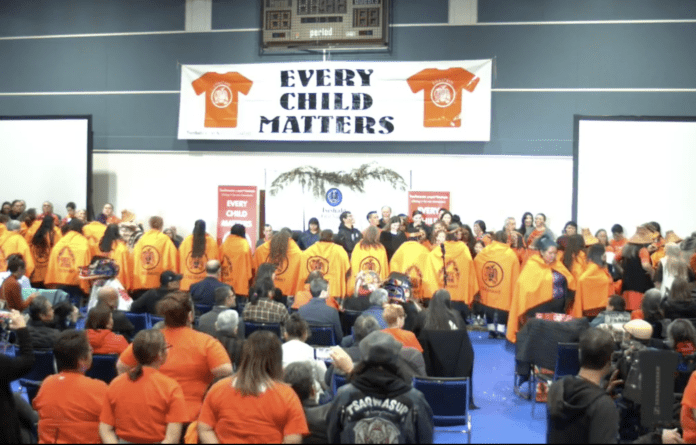WARNING: This story contains details some readers may find disturbing.
A team of researchers has announced the death toll at Port Alberni’s former residential school (AIRS) has been discovered to be at least 67 children, much higher than the 29 children reported by the National Centre for Truth and Reconciliation.
On Tuesday, February 21st, The ?uu?atumin yaqckwiimitqin (Doing it for our Ancestors) research team revealed children were taken from over 90 different reserve communities across BC, translating to over 70 First Nations communities throughout the province.
Of the 100 hectares of land in question, 10% of the land surveyed in 2022 has revealed 17 unmarked grave sites where Indigenous children rest.
Upon sharing the news of these unmarked graves, Ken Watts, Tseshaht First Nation Chief Wahmeesh asked those in attendance to join him for a moment of silence.
After a period of reflection, Watts addressed the significance of these numbers and the impact it has had on generations of Indigenous youth across British Columbia who were separated and segregated from their families and communities.
“I don’t want to just glance over this and just become another number. No disrespect to our media, but this country has become numb and just thinks it’s another number. We kind of ignore and brush it off, acting like it’s no big deal just to move on,” said Watts.
“For survivors this is the truth they’ve been sharing from the beginning, knowing children never made it home,” said Watts.
Through research, engagement, scanning and memorialization, the team have used these four pillars in their investigation to further examine the history of the missing and murdered Indigenous children that, to this day, have been left unknown.
“It’s been 50 years since the closure of AIRS. For the survivors who have passed on, particularly in the earlier generations pre-1940’s, there’s a gap and it will never be filled because the documents aren’t there and the survivors aren’t there to pass on their stories,” said lead researcher, Sheri Meding.
As part of the engagement process, researchers interviewed and documented the traumatic histories of survivors that endured years of abuse and neglect.
Throughout the statement-gathering process, survivors post-1941 advised the research team where to look regarding the locations of the 17 grave sites uncovered thus far. According to Meding, in several cases, the survivors were correct.
“They knew multiple locations. Some survivors actually drew a map with multiple locations of unmarked graves. We’ve heard the lived experiences of AIR survivors and stand with them, sharing the truth of their lived experiences. The research team wants to acknowledge that,” said Meding.
Using survivor accounts, archival research, old maps and aerial photos, Brian Whiting, Geophysics Division Manager from GeoScan led the search on the ground, using two primary technologies to uncover the unmarked grave sites.
Through LiDAR – a drone-based laser scanning technology – as well as ground-penetrating radar equipment (GPR), the team was able to uncover sites and remains previously unknown and undetected to the natural eye.
With the aid of LiDAR, the team was able to isolate tiny gaps in the surface of the ground where objects would normally go unseen.
Additionally, GPR would then use vibrations in areas of interest to reflect back changes in ground conditions deep beneath the surface.
Now more than a year into the on the ground research, Whiting said the hardest part is yet to come, “What we got done in 2022 was about 10%. We did about 10 hectares. We did it very thoroughly with at least two technologies for every scanned area. There’s a lot more to do and hard work ahead of us in terms of working in the forested areas,” said Whiting.
In the wake of these troubling findings, Watts says the efforts brought forth by the “ʔuuʔatumin yaqckwiimitqin” (Doing It for Our Ancestors) project will continue to work tirelessly to provide answers to the families of those who lost loved ones as students of AIRS.
“I want people to look and remember that those were just children. They passed away while here as AIRS students. Some of them managed to be brought back home while they were sick, and some didn’t. It’s our job as the Tseshaht First Nation to bring those spirits back,” said Watts.
Those in need of support may call the Indian Residential School Survivors Society toll-free at 1-800-721-0066 or 24-hour crisis line at 1-866-925-4419.



